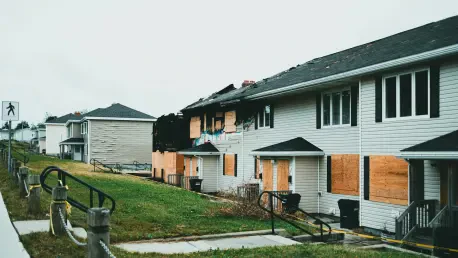The escalating challenges facing Florida’s homeowners in the insurance market are a direct consequence of the state’s vulnerability to extreme weather, particularly hurricanes. Places like Fort Myers Beach, represented by residents Dayna and Matt Fancher, serve as poignant examples. As the state grapples with the ramifications of a series of devastating storms, insurance premiums have soared, leaving many homeowners scrambling for coverage that adequately reflects the risk they face. Since 2021, severe hurricanes like Ian, Helene, Idalia, and Milton have wreaked havoc, not only on properties but also on the financial landscape of homeowners who must contend with increased insurance costs and limited compensation for rebuilds. This surge in natural disasters has driven premiums to unprecedented heights, yet insurers frequently fail to cover the actual costs of rebuilding, as seen in the Fanchers’ battle for a fair settlement.
The Costly Burden of Insurance Premiums
Living in a state that is a hotspot for hurricanes, many Florida homeowners bear the brunt of escalating insurance expenses that frequently outstrip the cost of rebuilding. The Fanchers, whose Fort Myers Beach home was severely damaged by Hurricane Ian, embody a widespread predicament where doubled insurance premiums come with limited recompense. Though they maintained their level of coverage, their insurer offered only a third of the total rebuild cost, forcing the couple to secure construction loans, highlighting a critical disjunction between cost and coverage quality. This misalignment exacerbates financial strains on homeowners, who face inflated premiums without the guarantee of adequate protection, compelling many to question the value of their investments against the sprawling threat of climate-fueled disasters.
The upward trajectory of insurance costs stems from a confluence of factors inherent to Florida’s unique exposure to hurricanes. The state’s precarious geographical positioning results in continuous scrutiny from insurance underwriters, justifying elevated premium rates. Exacerbating the situation, Florida has witnessed not only premium hikes but also a scarcity of choices among insurers over recent years. As the state braces for recurring natural catastrophes, the number of insurers providing coverage has dwindled, putting additional pressure on existing companies to balance risk management with affordability. This tightening market further inflates prices, making it increasingly challenging for Florida residents to secure insurance that aligns with their financial capabilities and their need for reliable coverage.
A Landscape Shaped by Market Dynamics
The insurance crisis gripping Florida exemplifies a broader economic and environmental tension. The state ranks as the most expensive area for homeowners insurance in the United States, with yearly premiums averaging around $10,000. At the local level, places like Fort Myers Beach have experienced steeper increases, with premiums rocketing from approximately $9,000 in 2019 to nearly $14,000. This local dimension mirrors a larger state challenge, fueled by over half a million catastrophe claims filed after Hurricane Ian alone. Such figures contributed to significant adjustments in the market landscape, prompting established insurers like Farmers to retreat, citing unsustainable risks associated with the heightened frequency of hurricanes.
Domestically, several Florida insurers have faced insolvency as a result of Hurricane Ian’s devastating $50-$65 billion insurance losses. This financial fallout has highlighted vulnerabilities within the insurance structure, illustrating the enormous pressure exerted by nature on economic systems. The departure of large insurance providers coupled with the collapse of local firms has further strained available options, pushing many policyholders towards state-backed programs. Citizens Property Insurance Corp., a government-established safety net, steps in to provide necessary coverage — albeit at a premium. As insurers recalibrate their approach to managing risk in an increasingly volatile climate, the balancing act between offering affordable premiums and ensuring comprehensive coverage becomes ever more difficult to maintain.
Legislative Responses and Future Outlook
Despite these challenges, recent legislative interventions have introduced glimmers of hope amidst the insurance turmoil. New laws, aimed at stabilizing the insurance domain, have enabled over a dozen insurers to re-enter the market. The changes, effective within the last calendar year, are designed to curb runaway premium increases and inject competition, thereby providing relief to the beleaguered Florida homeowner. Nonetheless, the broader ramifications of climate change, which fuels more intense and frequent storms, loom large over these regulatory victories. As the state faces the dual challenges of increasing average temperatures and rising sea levels, the growing severity and unpredictability of storms like Helene, where rainfall intensified significantly with trapped moisture, remain troubling.
Florida’s potential for adverse weather has necessitated a shift towards more resilient constructions. Communities have begun adapting to these persistent threats by embracing construction practices that can better endure the impact of floods and storms. Elevated structures, designed to withstand surging floodwaters, mark an era of architectural innovation tailored for adverse climate conditions. These efforts, however, represent a reactive measure amidst a broader failure to confront the root cause of climate change. Without addressing this fundamental issue, homeowners remain burdened by the unyielding threat of financial depletion, heightened by the need for insurance coverage capable of mitigating climate-induced uncertainties.
Continuing adaptation strategies necessitate enhanced cooperation between policymakers, communities, and the insurance industry to effectively mitigate the compounding effects of climate change. As Florida’s insurance market navigates current challenges, a balanced approach emphasizing resilience, affordability, and comprehensive coverage must prevail to ensure that homeowners can securely weather the financial ripples of escalating environmental risks.
The Dilemma of Balancing Risks and Rewards
In Florida, a state frequently targeted by hurricanes, homeowners face mounting insurance costs that often surpass rebuilding expenses. Take the Fanchers, for example; their home in Fort Myers Beach suffered significant damage from Hurricane Ian. Although they kept their coverage steady, their insurer covered only a third of the rebuilding costs, pushing them to seek construction loans. This reflects a broader issue where insurance premiums rise without ensuring adequate protection, leading many homeowners to reassess their investments amidst growing climate risks.
Several factors contribute to Florida’s soaring insurance rates, especially the state’s unique susceptibility to hurricanes. Its geographical location invites constant evaluation from insurers, thereby justifying higher premiums. Further compounding the problem, Florida has seen premium increases coupled with diminishing insurer options. As the state anticipates more natural disasters, fewer companies offer coverage, heightening pressure on existing providers to juggle risk management and cost. This strained market consequently drives up prices, complicating efforts for Floridians to find affordable, dependable insurance.









